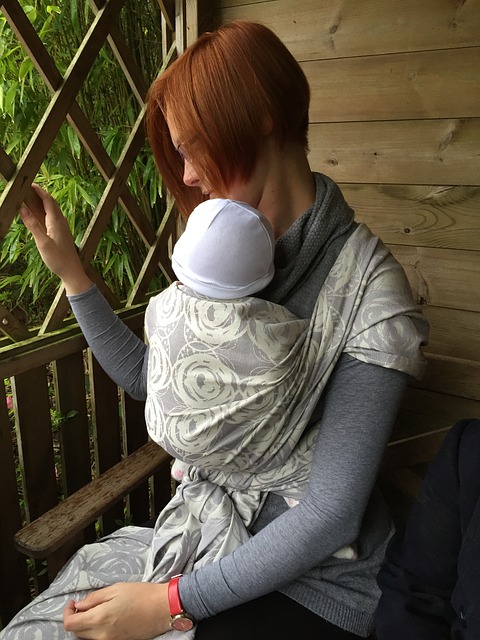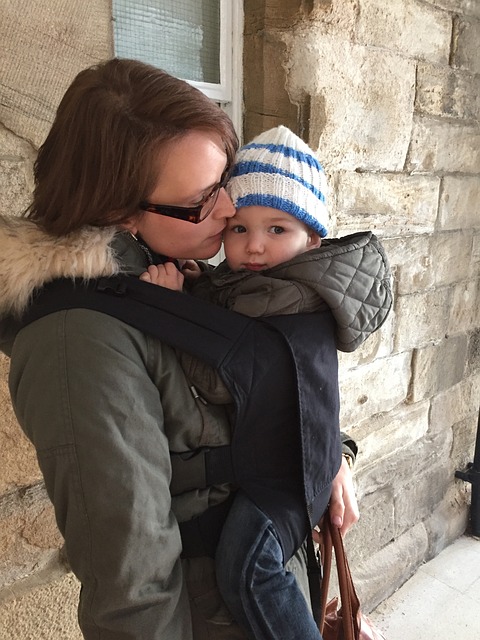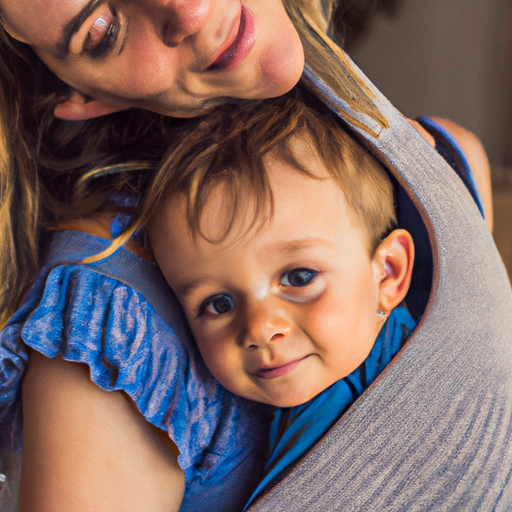Have you ever wondered about the benefits of babywearing? Well, let me tell you, there are quite a few! Babywearing is when you use a carrier or sling to hold your baby close to you while you go about your day. It not only allows for convenience and hands-free movement, but there are also numerous benefits for both you and your little one. Whether it’s promoting bonding, enhancing caregiver’s confidence, or providing comfort and security to your baby, babywearing has a lot to offer. So, if you’re curious to learn more about the benefits of babywearing, keep reading!
In this article, we’ll dive deeper into the advantages of babywearing and explore how it can positively impact various aspects of your life. From reducing crying and fussiness to facilitating breastfeeding and aiding in baby’s physical development, babywearing has a host of benefits that every parent should know about. We’ll also discuss the different types of carriers available, safety guidelines to keep in mind, and some useful tips for successful babywearing. By the end of this article, you’ll have a better understanding of why babywearing is more than just a trendy parenting choice and why it might be something worth considering for you and your little one. So, let’s get started and uncover the amazing benefits of babywearing together!

What is Babywearing
Babywearing is the practice of using a baby carrier or sling to hold and carry your baby close to your body. It is a traditional practice that has been used by parents for centuries and continues to be a popular choice for many families today. Babywearing provides numerous benefits for both parents and babies, promoting physical and emotional development, enhancing attachment and bonding, and offering convenience and practicality in daily life.
Definition of babywearing
Babywearing refers to the act of using a fabric or structured carrier to hold your baby close to your body, allowing you to carry them hands-free. It involves wearing a carrier or sling around your chest, shoulder, or waist, depending on the type of carrier used. By keeping your baby close, babywearing creates a nurturing and secure environment that promotes bonding, physical safety, and overall well-being.
Different types of baby carriers
There are various types of baby carriers available on the market, each offering different features and benefits. Some popular types of baby carriers include:
- Wrap-style carriers: These carriers consist of a long piece of fabric that can be wrapped around your body to create a secure and comfortable pouch for your baby.
- Soft-structured carriers: Soft-structured carriers have padded shoulder straps and a waistband, providing support for both you and your baby. They are easy to adjust and offer versatility in carrying positions.
- Ring slings: Ring slings are made of a long piece of fabric with two rings attached to one end. The fabric is threaded through the rings, creating a secure pouch for your baby.
- Mei Tais: Mei Tais are a hybrid between a wrap and a soft-structured carrier. They have a rectangular body panel with straps that can be tied around your waist and shoulders.
By exploring these different types of carriers, you can find the one that suits your needs and preferences best.
Physical Benefits of Babywearing
Promotes bonding between parent and baby
Babywearing fosters a strong bond between parents and their babies. By keeping your baby close to your body, you can have constant physical contact and easily respond to their needs. This close proximity and increased skin-to-skin contact promote bonding, trust, and attachment between you and your little one.
Supports proper hip and spine development
Proper hip and spine development is crucial for babies, especially during their first months of life. Baby carriers that promote the “M” position, with the baby’s legs spread apart and knees higher than their bottom, help support healthy hip development. Carriers that provide adequate support and maintain the natural position of the spine also contribute to proper alignment and growth.
Reduces the risk of flat head syndrome
Flat head syndrome, or plagiocephaly, is a condition where the back or side of a baby’s head becomes flattened due to prolonged pressure. Babywearing helps reduce the risk of flat head syndrome by preventing constant pressure on a specific area of the head. The constant movement and repositioning of the baby’s head while in a carrier help distribute the weight evenly and promote a rounder head shape.
Aids in digestion and reduces colic
The gentle movements and upright position that babywearing provides can aid in digestion and reduce colic symptoms in babies. The closeness to your chest and the slight pressure on their abdomen mimics being held in your arms, which can relieve gas and promote healthy digestion.
Provides a secure environment for baby’s physical safety
Baby carriers are designed to provide a safe and secure environment for your baby. The snug fit and proper positioning of the carrier ensure that your baby is held securely against your body, reducing the risk of accidental falls or injuries. Additionally, babywearing allows you to navigate crowded or uneven terrain more easily, ensuring your baby’s safety in various environments.
Emotional Benefits of Babywearing
Enhances parent-infant attachment
By keeping your baby close to your body, babywearing enhances the emotional attachment between you and your little one. The physical contact, close proximity, and ability to respond quickly to your baby’s cues help establish a strong emotional connection. This attachment is essential for building trust and promoting healthy emotional development.
Calms fussy babies and reduces crying
The gentle motions and rhythmic movements of walking or swaying while babywearing have a calming effect on babies. The warmth, scent, and sound of your body provide a soothing environment, helping to soothe a fussy or colicky baby. Studies have shown that babies who are worn in a carrier cry less and have increased periods of contentment.
Promotes a sense of security and trust
Being held close to their parent’s body in a baby carrier provides a sense of security and trust for babies. This closeness allows them to feel safe and protected, reducing anxiety and promoting a sense of overall well-being. As they grow older, this sense of security can help them navigate new environments and experiences with confidence.
Increases caregiver confidence and responsiveness
Babywearing allows caregivers to quickly and easily respond to their baby’s needs. This increased responsiveness and closeness can boost caregiver confidence, as it helps them feel more in tune with their baby’s cues and signals. It provides an opportunity for caregivers to learn and understand their baby’s needs and preferences, enhancing their parenting skills.
Convenience and Practicality of Babywearing
Leaves hands free for other tasks
One of the most significant advantages of babywearing is that it allows you to have your hands free for daily tasks and activities. With your baby securely held in a carrier, you can tend to household chores, run errands, or simply enjoy a moment for yourself while still providing the comfort and security your baby needs.
Easy transportation and mobility
Baby carriers are lightweight and portable, making them convenient for transportation and mobility. Whether you’re walking, taking public transit, or traveling, a baby carrier allows you to navigate through different environments with ease. It eliminates the need to maneuver bulky strollers through crowded spaces or navigate stairs and uneven surfaces.
Simplifies breastfeeding on-the-go
For breastfeeding mothers, babywearing simplifies nursing on-the-go. With a carrier that allows for discreet breastfeeding, you can conveniently nurse your baby while remaining mobile and active. This makes it easier to breastfeed in public without the need for extra equipment or finding a private space.
Reduces the need for strollers and bulky equipment
Babywearing eliminates the need for a stroller in many situations. Instead of carrying around a bulky stroller, you can use a carrier to provide a comfortable and secure place for your baby to rest or sleep while you attend to your daily tasks. This reduces the amount of equipment you need to carry and simplifies outings, particularly in crowded or narrow spaces.

Promotes Social Interaction and Learning
Allows baby to observe and engage with the environment
Babywearing allows your baby to observe and engage with their surroundings while still feeling safe and secure. The upright position and close proximity to your body provide them with a unique perspective, allowing them to explore the world from a comfortable vantage point. This exposure to different sights, sounds, and experiences promotes curiosity, cognitive development, and sensory stimulation.
Offers opportunities for verbal and sensory stimulation
Being carried in a baby carrier offers opportunities for verbal and sensory stimulation. Babies can interact with their caregivers through conversation, providing language exposure and promoting communication skills. Additionally, the close physical contact and body movements while babywearing offer a rich sensory experience, stimulating the baby’s senses and contributing to their sensory and motor development.
Encourages socialization and bonding with others
Babywearing allows your baby to be at eye level with other people, promoting social interaction and bonding. Babies carried in a carrier are more likely to engage with people around them, whether it’s their caregivers, family members, or strangers. This interaction helps to foster social skills and contributes to their emotional and social development.
Supports cognitive and language development
The close proximity and constant interaction that babywearing provides support cognitive and language development in babies. Being able to observe and engage with their caregivers and the environment enhances their ability to learn, make connections, and develop important cognitive and language skills. The increased exposure to language and social cues helps babies develop communication and language skills from an early age.
Health Benefits for Parents
Reduces back and shoulder pain from carrying baby
Carrying your baby for extended periods can lead to back and shoulder pain, especially as they grow and gain weight. Baby carriers are designed to distribute the weight more evenly across your body, reducing strain on your back and shoulders. By using a carrier that provides proper support and adjusting the straps correctly, you can alleviate discomfort and prevent long-term postural issues.
Enhances parent’s physical fitness
Babywearing can contribute to your physical fitness as a parent. The added weight of the baby creates natural resistance, making everyday activities such as walking or climbing stairs more challenging. This increased physical exertion can help improve cardiovascular health, strength, and endurance over time, contributing to your overall fitness level.
Boosts mental well-being and reduces postpartum depression
The close physical contact and bonding experience of babywearing have a positive impact on a parent’s mental well-being. The release of oxytocin, often referred to as the “love hormone,” during skin-to-skin contact and the nurturing experience can help reduce stress, anxiety, and symptoms of postpartum depression. Babywearing allows parents to feel connected, supported, and emotionally fulfilled, which can have a significant impact on their mental health.

Tips for Safe Babywearing
Choose a carrier that provides proper support
When selecting a baby carrier, choose one that provides adequate support for both you and your baby. Look for carriers that have wide and padded shoulder straps, waistbands, and back support for optimal comfort and weight distribution. Ensure that the carrier is appropriate for your baby’s age and weight, and follow the manufacturer’s guidelines for proper use.
Ensure baby is positioned comfortably and securely
When using a baby carrier, it’s essential to ensure that your baby is positioned comfortably and securely. The carrier should support your baby’s neck and head and allow for proper leg and hip alignment. Avoid carriers that force your baby into a curled position, as it may restrict airflow. Regularly check on your baby’s positioning and make any necessary adjustments for their comfort and safety.
Be mindful of the baby’s breathing and body temperature
While babywearing, it’s crucial to be mindful of your baby’s breathing and body temperature. Ensure that their airways are clear and unobstructed, and regularly check on their breathing. Baby carriers can create a warm environment, so dress your baby in appropriate clothing and monitor their body temperature to prevent overheating.
Take breaks and rest when needed
Listen to your body and your baby’s cues and take breaks when needed. Babywearing can be physically demanding, especially for longer periods. If you feel discomfort or fatigue, take a break and rest. It’s essential to prioritize your well-being and ensure that both you and your baby are comfortable and safe while babywearing.
Different Babywearing Techniques
Front carry
Front carry is one of the most common babywearing techniques, suitable for both newborns and older babies. It involves wearing your baby in a carrier at the front of your body, facing inward towards your chest. This position allows for easy bonding and constant interaction with your baby. Learn more about encouraging your baby to take naps during the day.
Back carry
Back carry is a more advanced babywearing technique that is suitable for older babies with proper head and neck control. It involves wearing your baby on your back, using a carrier that allows for a secure back carry position. This technique provides more freedom of movement for the caregiver and allows the baby to observe their surroundings.
Hip carry
Hip carry is another versatile babywearing technique that allows for a natural and comfortable position for both you and your baby. It involves wearing your baby on your hip in a carrier that supports their weight and provides proper support. This position is particularly useful for older babies who want to explore their environment while still maintaining closeness to their caregiver. Learn more about safe ways to hold and carry a baby.
Newborn-specific holds
For newborns or babies who require additional head and neck support, specific holds or positioning techniques can be used. These techniques, such as the cradle or the tummy-to-tummy hold, provide a secure and comfortable position for your baby while ensuring their safety and well-being.

Ideal Age and Weight for Babywearing
Babywearing is suitable for newborns to toddlers, depending on the type of carrier and their weight limits. Newborns can be safely worn in carriers that provide proper head and neck support, while older babies and toddlers can be comfortably carried in carriers designed for higher weight capacities. It’s important to consider the specific guidelines and recommendations from the manufacturer and ensure that the carrier is appropriate for your baby’s age and weight. Learn more about when to start tummy time for your baby.
Considerations for premature or low birth weight babies
If you have a premature or low birth weight baby, it’s essential to consult with your healthcare provider before engaging in babywearing. Premature and low birth weight babies may require additional medical or developmental considerations, and your healthcare provider can offer guidance and recommendations specific to your baby’s needs. Learn more about recognizing signs of discomfort or illness in your baby.
Conclusion
Overall, babywearing offers numerous benefits for both babies and parents. From promoting physical and emotional development to providing convenience and practicality, babywearing enhances the bond between parent and baby and supports healthy growth. By understanding the different types of carriers, following safety guidelines, and practicing appropriate babywearing techniques, parents can enjoy the advantages of babywearing while keeping their little ones safe and secure.
Whether you choose a wrap, soft-structured carrier, ring sling, or mei tai, embracing babywearing can have a positive impact on your parenting journey. The physical, emotional, and practical benefits make babywearing an excellent choice for families seeking closeness, convenience, and enhanced bonding with their little ones. So, take the time to explore the world of baby carriers and find the one that works best for you and your baby. Happy babywearing!





